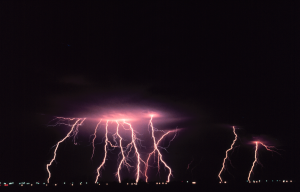
Cloud to ground lightning
Typical Formation of Cloud-to-Ground Lightning. Lightning manifests due to the breakdown of the insulating property of dry air. When the localized electrical potential gradient exceeds about three million volts within fifty meters, the phenomenon shoots electrons into a cloud and toward the ground as a stepped leader. Composed of discharges spanning about fifty to a hundred meters with breaks of fifty millionths of a second in-between, stepped leaders are invisible to the naked eye. A typical lightning flash has three or four leaders. When they approach the ground, the local voltage per meter increases and initiates a current of positive charge upward. Electrons flowing through the positive charge to the surface produce return strokes, which are several centimeters thick and far more luminous. The same leader/return procedure can be repeated every four hundredths of a second or so. A new type of lightning called a dart leader can now follow the original path faster because of the reduced electrical resistance. Dart leaders fork when they deviate from their original paths.
Out of the top of the momentarily established channel, within about a tenth of a second after the strongest strike, additional lightning is possible in the forms of K and J streamers, which connect to more distant parts of the storm. In most mountain top and tall building flashes, stepped leaders move toward clouds. Approximately ten seconds between strikes are required for the local refurbishment of electrification from winds replacing the air. If wind sufficiently moves an ionized channel during a lightning strike, ribbon lightning can form.
Positive lightning is made by the opposite polarization: positively-charged clouds and a negatively-charged surface. The strikes typically produce a longer flash, 10% more current and are almost exclusively produced by supercells.
Only 10-20% of lightning reaches the ground, which is estimated at about 20 million strikes in the US annually. They typically kill eighty annually. 85% of victims are children and men who are working or playing outside. Of those struck, one of ten walks away basically fine, two perish and seven endure lifelong injuries.
There are around 200,000 insurance claims for lightning strikes annually in the US and a billion dollars worth of damage is typical. The electric power industry independently endures about a billion dollars of damage regularly. Aircraft mishaps, forest fires and damage to objects like petroleum containers together sum to a similar tally. Lightning causes about 26,500 house fires regularly. Coverage for lightning-related damage is offered by homeowners and business insurance policies.
What can be done to help? Staying inside during thunderstorms is an effective solution. A home or business owner who roofs with tile or slate and also installs a lightning rod is about seven times less likely to have their building struck by lightning. Electric power companies may just have to tough it out due to the natural consequences of using electricity and electrical grids to generate profits. Forest fires started by lightning are probably impossible to prevent but are arguably a part of natural forest clearing in an ongoing boreal cycle of rejuvenation. Human efforts may be best directed toward containment to protect homes and businesses.
The formation of cloud-to-ground lightning is complex, involving probabilities of combinations of changing variables circumstantially equating. Tingling skin and clicking sounds are signs of an incoming lightning strike – an often fatal touch from a force that’s typically five times hotter than the surface of the sun.
Written by Meteorologist Geoff Linsley
Cloud to ground lightning